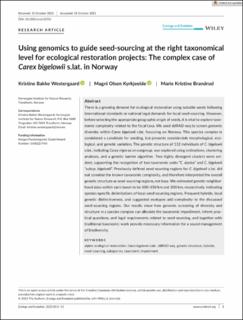| dc.description.abstract | There is a growing demand for ecological restoration using suitable seeds following international standards or national legal demands for local seed-sourcing. However, before selecting the appropriate geographic origin of seeds, it is vital to explore taxonomic complexity related to the focal taxa. We used ddRAD-seq to screen genomic diversity within Carex bigelowii s.lat. focussing on Norway. This species complex is considered a candidate for seeding, but presents considerable morphological, ecological, and genetic variation. The genetic structure of 132 individuals of C. bigelowii s.lat., including Carex nigra as an outgroup, was explored using ordinations, clustering analyses, and a genetic barrier algorithm. Two highly divergent clusters were evident, supporting the recognition of two taxonomic units “C. dacica” and C. bigelowii “subsp. bigelowii”. Previously defined seed-sourcing regions for C. bigelowii s.lat. did not consider the known taxonomic complexity, and therefore interpreted the overall genetic structure as seed-sourcing regions, not taxa. We estimated genetic neighborhood sizes within each taxon to be 100–150 km and 300 km, respectively, indicating species-specific delimitations of local seed-sourcing regions. Frequent hybrids, local genetic distinctiveness, and suggested ecotypes add complexity to the discussed seed-sourcing regions. Our results show how genomic screening of diversity and structure in a species complex can alleviate the taxonomic impediment, inform practical questions, and legal requirements related to seed-sourcing, and together with traditional taxonomic work provide necessary information for a sound management of biodiversity. alpine ecological restoration, Carex bigelowii s.lat., ddRAD-seq, genetic structure, hybrids, seed-sourcing, subspecies, taxonomic impediment | en_US |

